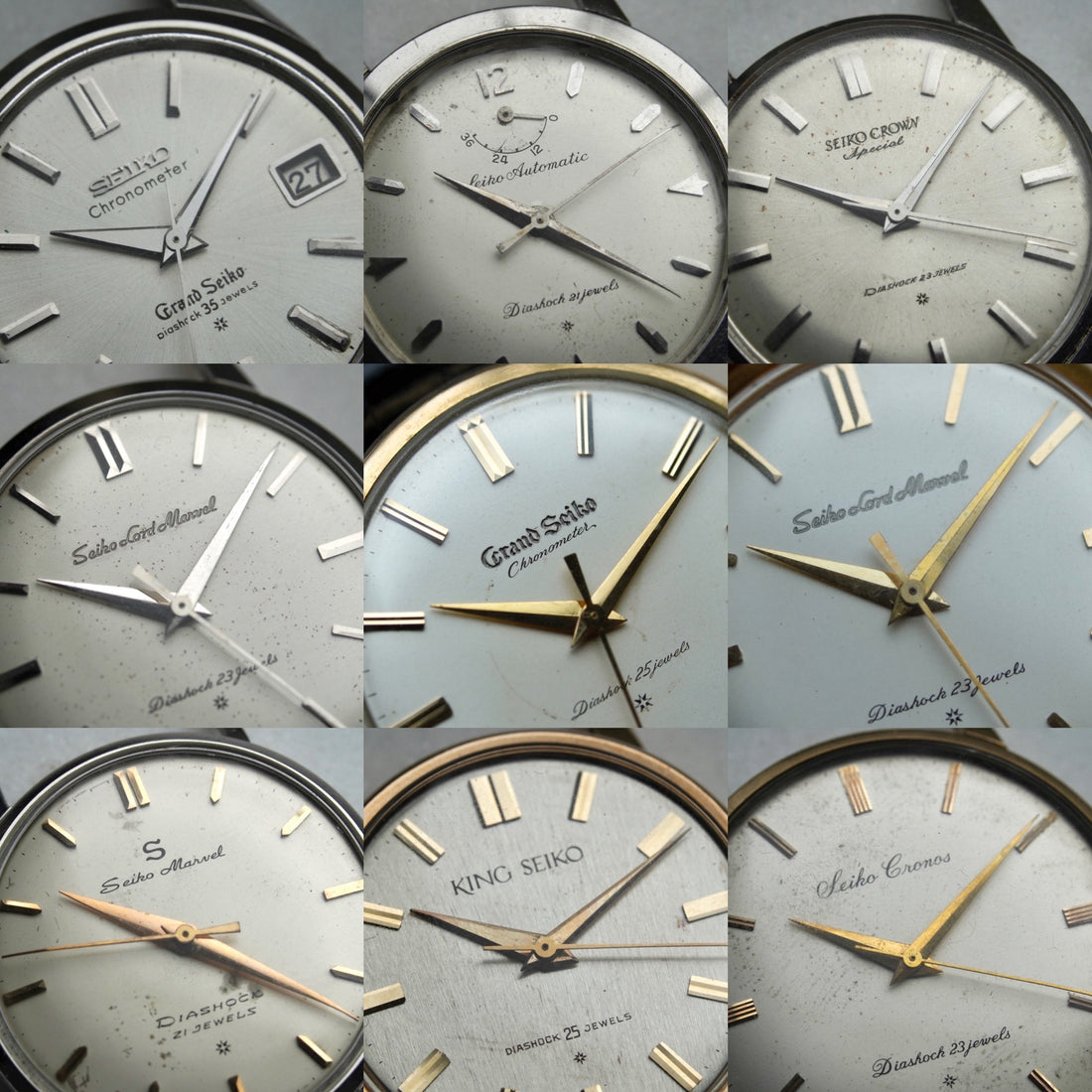The history of the Special Dial
The first Seiko wristwatch to don the Special Dial (SD) logo was the Seiko Marvel, which started production in June 1956. The Marvel was initially fitted with a 17 jewel movement and these early Marvel’s did not feature the SD logo but rather a “17 jewels” and “anti shock”or “diashock” printing above the six o’clock index.

 The 19 jeweled Marvel introduced in the summer of 1957 similarly never featured a SD logo. It was only in the 21 jeweled Marvel that the Special Dial (SD) logo made its first appearance. The 21 jeweled Marvel is famous among Japanese collectors for its rarity (out of all the Marvel’s produced it is believed less than 5% were 21 jeweled) as well as the mysterious circumstance surrounding its production date. Initially recorded in Seiko’s dealers catalogue as going on sale in July 1957, the 21 jewel Marvel mysteriously disappeared in all subsequent catalogues until it was reintroduced on the December 1958 catalogue as a more affordable alternative to the Lord Marvel that went on sale earlier that year.
The 19 jeweled Marvel introduced in the summer of 1957 similarly never featured a SD logo. It was only in the 21 jeweled Marvel that the Special Dial (SD) logo made its first appearance. The 21 jeweled Marvel is famous among Japanese collectors for its rarity (out of all the Marvel’s produced it is believed less than 5% were 21 jeweled) as well as the mysterious circumstance surrounding its production date. Initially recorded in Seiko’s dealers catalogue as going on sale in July 1957, the 21 jewel Marvel mysteriously disappeared in all subsequent catalogues until it was reintroduced on the December 1958 catalogue as a more affordable alternative to the Lord Marvel that went on sale earlier that year.
 It was with this 21 jewel Marvel that started the estimated six year production run of the Special Dial (SD) logo with solid gold index which employed the ”shokuji” planted technique. (to learn more about the "shokuji" technique, read our post in part 1)
It was with this 21 jewel Marvel that started the estimated six year production run of the Special Dial (SD) logo with solid gold index which employed the ”shokuji” planted technique. (to learn more about the "shokuji" technique, read our post in part 1)
 Subsequent models known to have planted Special Dial solid gold index include (year indicates estimated production years of the SD dial model):
Subsequent models known to have planted Special Dial solid gold index include (year indicates estimated production years of the SD dial model):






For unknown reason, the Special Dial logo abruptly started to disappear in 1964 (production of SD dials most likely ended by 1963 or early 1964). Subsequent dials all had either the AD (applique dial) or ED (extra dial) logo above the six o’clock. The AD dial index were made of SGP or "strong" gold plating (or for silver colored index, rhodium plating) a material that Seiko perfected in 1963. Both the gold and rhodium plated material were resilient against the humidity of Japanese summers and had a finish similar to the solid gold SD index.
With the development of the AD dial complete, Seiko gradually moved away from SD solid gold dials starting from the lower end models and completely made the switch to gold/rhodium plated AD dials by early 1964. If you ever wondered what the AD meant in the bottom of your King Seiko and Grand Seiko dials, now you know.

 Collectability of the SD dials
Collectability of the SD dials
Here’s a picture of a 44 King and a Hibeat Lord Marvel - both with the AD text at the bottom of the dial .

 Collectability of the SD dials
Collectability of the SD dials
Even in Japan, not many people know about the SD, AD, and ED logo Seiko dial variations and what each represent. As such, for many of the models (such as the Liner or Gyro Marvel) currently there is no big price difference between each of the three variations. This was certainly not the case when these models were first released with the price difference for a SD versus a non-SD dial set at least ¥1,000 higher (adjusted for inflation that is over ¥16,000 or USDe 150).
To no one’s surprise, the most collectible SD dial model is the Grand Seiko First. All GS1st dials had the SD logo except some produced in 1963 with an AD logo. It is interesting to note that the AD GS1st has a sun burst finish to the dial - which gives it a completely different look from the better known cream white colored dials of the SD variant. With the rarity of AD GS1st’s, one can argue that it is even more collectible than the the more common SD variant.




The King Seiko First SD variant is another collectible and interesting model. In Japan, KS1st AD dials are quite abundantly found as replacement dials and many collectors never fully understood why this was the case. The most plausible and popular theory is that the early KS1st textured SD dials commonly started turning purple due to a defect in the dial. Due to this, Seiko hastily produced AD dials as free replacements for those affected by the defect. Some old time collectors here have supported this theory, recollecting a time where Seiko performed a “recall” of KS1st’s. Whether this is true or not, there is no doubt that there is a lot less KS1st SD dial’s when compared to the AD dial which definitely makes them collectible.

 In my personal view, although the yellow gold SD dials are very attractive, the stainless steel cased SD dials with white gold index are the most intriguing out of the bunch. The subtlety of the SS SD’s is very attractive - without knowledge, who would ever guess that a stainless steel cased vintage Seiko would be using white gold! Three of my favorites are the 11a SD dial, 43999 SD dial and the 1st generation Lord Marvel stainless steel carved logo SD dial. For collectors on the know, all three are very popular for its beauty and the great thing is that they are still relatively affordable (although western collectors are starting to catch onto these).
In my personal view, although the yellow gold SD dials are very attractive, the stainless steel cased SD dials with white gold index are the most intriguing out of the bunch. The subtlety of the SS SD’s is very attractive - without knowledge, who would ever guess that a stainless steel cased vintage Seiko would be using white gold! Three of my favorites are the 11a SD dial, 43999 SD dial and the 1st generation Lord Marvel stainless steel carved logo SD dial. For collectors on the know, all three are very popular for its beauty and the great thing is that they are still relatively affordable (although western collectors are starting to catch onto these).


 SD dials also exist in the modern Grand Seiko line up. Although most were produced as an homage to the original GS1st, the recent (GS 60th anniversary) SLGH002 is my personal favorite with its distinct dial and case design, alongside an innovative new movement, the 9SA5, featuring the impressive dual impulse escapement.
Below are the modern GS models that we know of sporting an SD logo.
SD dials also exist in the modern Grand Seiko line up. Although most were produced as an homage to the original GS1st, the recent (GS 60th anniversary) SLGH002 is my personal favorite with its distinct dial and case design, alongside an innovative new movement, the 9SA5, featuring the impressive dual impulse escapement.
Below are the modern GS models that we know of sporting an SD logo.





SBGW 257 platinum, 258 gold, (259 SS)
SBGW 251 platinum, 252 gold, (253 SS)
SBGW 004
SLGH 002
In conclusion
We hope you enjoyed this two part series on the Special Dial. When one looks back at the history of Seiko, you can see that the production of Special Dial Seiko models played an important role for the company in laying the foundation of the skills and techniques required to produce a top quality watch involving expert craftsmanship. Many of these skills and tradition continue to this day in modern Seiko watches.








This is by no means a complete history of Special Dial Seiko’s and if anyone has more information or a model not listed on our table we would be interested to hear from you.
References:
国産腕時計セイコー自動巻 森 年樹
国産腕時計セイコークラウン、クロノス、マーベル 長尾善夫 本田義彦
セイコーミュージアム銀座

